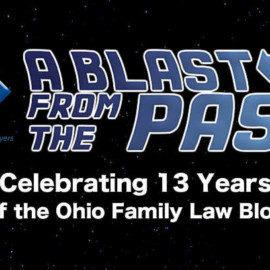
Why is Discovery in Ohio Divorce So Confusing? Here are the First Steps you Should Take!
 Discovery in a divorce or dissolution case can be a confusing part of the litigation process. It occurs in the initial pre-trial aspect of the proceeding. The ultimate purpose or goal of discovery is to make sure that both sides have all the relevant information about the factual particulars of the case. It is designed to avoid “trial by ambush” and to encourage negotiations between the lawyers after having a full understanding of all potential evidence. Ohio law allows for attorneys to request and receive almost anything which “could” lead to admissible evidence at trial. So, the scope of permissible discovery is very broad!
Discovery in a divorce or dissolution case can be a confusing part of the litigation process. It occurs in the initial pre-trial aspect of the proceeding. The ultimate purpose or goal of discovery is to make sure that both sides have all the relevant information about the factual particulars of the case. It is designed to avoid “trial by ambush” and to encourage negotiations between the lawyers after having a full understanding of all potential evidence. Ohio law allows for attorneys to request and receive almost anything which “could” lead to admissible evidence at trial. So, the scope of permissible discovery is very broad!
I. Discovery/Disclosure in a DISSOLUTION:
In a dissolution action, the entire proceeding is premised on each party making a complete disclosure of all his/her assets and liabilities to the other. The “discovery” is intended to be informal and cooperative as both parties need to come to a 100% agreement on all issues before the action is even filed with the Court.
Basic “discovery” is accomplished in the exchange of the fully completed Financial Disclosure Affidavits between them. The logic is that the two parties need to fully understand the nature and extent of each other’s respective financial assets and debts BEFORE they can knowingly agree to fair settlement terms.
We posted a blog on October 9, 2010 about “The Importance of a Correctly Completed Affidavit of Financial Disclosure”. Those basics are “on point” even 13 years later! Click here to read it. Here is the link to the Montgomery County Ohio Domestic Relations Court current Affidavit of Financial Disclosure form. Completing it is a prerequisite that must be done in both a dissolution and a divorce action.
II. Discovery in a DIVORCE:
“Discovery” is the process to obtain and exchange all the documents and information which may lead to evidence to be used in the proceeding. This can be a time consuming endeavor but an important and necessary component of the divorce process.
Completing the Affidavit of Financial Disclosure (linked to above) is often just the first step. Most Courts also have local rules designed to encourage open and automatic exchange of basic financial information. For example, Montgomery County Domestic Relations Court Local Rule 4.18 (E) states:
(E) Mandatory Disclosure. Each party has the affirmative duty to disclose to the other party the following information and documents:
- All pension and profit-sharing plans including the most recent plan summary;
- >All COBRA benefits to which the other party may be entitled;
- Copies of all real estate deeds, vehicle titles and registration, unless already in the possession of the other party;
- All appraisals of real estate or personal property or any business property in which the party holds an interest;
- Copies of the last 3 years individual tax returns, unless already in the possession of the other party;
- Documentary proof of current income from all sources; and
- Copies of the most recent statements on all bank accounts, IRA’s, stock accounts, mortgages, credit card accounts, and other debts.
III. Additional Methods for Other Divorce Discovery:
A. Interrogatories.
These are written questions that the responding party must answer under oath, and under the penalty of perjury. These can cover a very broad range of issues (not just financial ones) that are designed to lead to relevant evidence at trial.
Most lawyers will ask their client to write out their response to each of the questions as a starting point and then will re-work them as appropriate. There may be several sets of Interrogatories as the case and issues unfold. Expect that if you serve a set of these on your spouse that he/she will send back a reciprocal set for you to complete as well!
B. Request for Production of Documents.
These are typically sent along with the Interrogatories, but can also be served separately. Obtaining copies of documents pertaining to financial information, email, text messages, photos, appraisals, bank and credit card statements, tax returns, and retirement statements is often necessary. Again, just like with Interrogatories, these requests must be completed under oath and the penalties of perjury.
C. Request for Admissions.
These are much less commonly used in divorce actions than Interrogatories and Request for Production of Documents. They are a series of short, direct questions to be admitted or denied which are intended to narrow issues in dispute. They can also be powerful evidence to “box in” a party to respond directly to issues and to make it more difficult for them to renege or alter their position on the question.
D. Subpoenas.
These are legal requests mailed to persons or entities who typically are not parties to the divorce litigation. They are sent to banks, brokers, medical providers, employers, social media platforms, title companies, cell phone providers, etc. They can be costly and slow in obtaining the information/documents sought. Success can be “hit or miss” especially with social media platforms (although, interestingly, I recently was successful obtaining income information from OnlyFans).
E. Depositions.
After exchanging the various discovery types and information above, depositions may be scheduled and conducted. They are typically set fairly close to the trial date. A court reporter will be present and the lawyer asks the party or witness oral questions under oath and the penalty of perjury. The Court reporter then records and will transcribe the testimony and produce a transcript if paid to do so.
Depositions are intended to give the lawyer a clearer picture of the factual issues and to observe how the witness might actually testify at trial. Expert witnesses can also be deposed. Depositions are less frequent these days than they were a decade ago in part due to their costs and the increase of mediation and settlement conferences.
IV. Why Discovery is Critical.
You need to be honest and forthcoming with your lawyer in producing the requested discovery (and in all aspects of your representation)! Trying to ignore or avoid providing any requested discovery is a huge mistake. If you get caught hiding information or documents it can be devastating to your case and with the Judge! Being completely forthright with your lawyer will allow him/her to properly prepare and ultimately represent your best interests.
We are Experienced, Trusted and Professional Dayton Divorce Lawyers
Do you need help with Ohio divorce, dissolution, or possible custody case? We can assist you immediately. To learn more, please go to our website at www.hcmmlaw.com or call us at937 293-2141. We can schedule an in-person conference or one by phone or Zoom.
Please consider joining or following us!© 2023, Ohio Family Law Blog. All rights reserved.

Attorney Robert “Chip” Mues has been focusing his legal practice throughout Southwest Ohio primarily in divorce and family law matters since 1978. Chip is passionate about family law and has proudly published the Ohio Family Law Blog since 2007. In addition, he previously managing the Dayton law firm of Holzfaster, Cecil, McKnight & Mues LPA until it dissolved on December 31, 2024. He recently has founded MUESLAW in 2025. To learn more about him or MUESLAW, visit www.MuesLaw.com. Appointments are available in person, over the phone or by Zoom. Call us at 937 293-2141.




